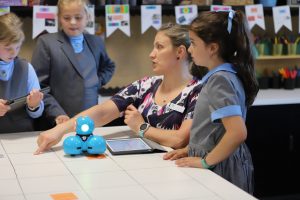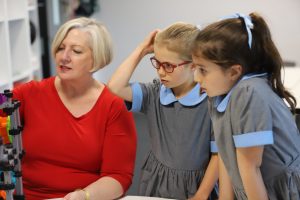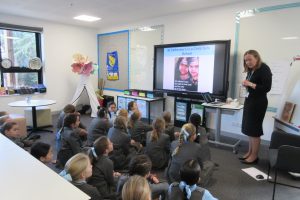Striving For Continuous Improvement

Continuous improvement can be defined as ‘the ongoing improvement of products, services and processes through incremental and breakthrough improvement’ (American Society for Quality). While this model has long been applicable for businesses and industry, it can also be applied to education on a number of levels.
At a School level, we strive to continually improve by making sure our programs and offerings are current and our staff receive ongoing professional development. This year, a number of staff have enrolled in Harvard University courses: ‘Cultures of Thinking’ and ‘Making Thinking Visible’. In response to the value that the staff saw in these courses, the Junior School is planning (Plan) to introduce a thinking lesson, ‘Cognition Program’, for Years Prep to 6 in 2020. Once designed and implemented (Do), the staff will evaluate its effectiveness throughout the year (Check) and then amend (Act) based on the results before starting the process again. While this is one example, the process is used continually throughout the Junior School across all departments and administrations.

St Catherine’s Junior School strives to continually improve by making sure our programs and offerings are current and our staff receive ongoing professional development.
At the teacher level, we continually use this process in the classroom. Teachers plan lessons, teach and check the effectiveness of their teaching using formative assessment. Based on the results of these assessments, they group students with like-needs and design programs for those groups (differentiation), starting the model’s cycle again. Effective teachers use this model throughout their day as they teach, constantly looking for ways to improve the learning outcomes of their students.

The success in using this model is that the School, teacher or student must be able to self-assess and analyse their work critically.
At a student level, they can apply this model to their own learning and school work. For example, they might determine that not knowing their times tables is holding them back or they realise they need to use more phrases in their writing. They then plan to learn their times tables or insert more phrases in their writing. Once learnt, they apply their plan and assess its effectiveness: Was it easier to do the algorithms and did they get more correct? Did the phrases improve the sentence and did they receive better marks? For the student learning times tables, they might determine that they still need to work on their 9 times tables, while the writer might determine that they can now use adjectival phrases well but need to include more adverbial phrases. This new plan initiates the new cycle of the model.
The key to the success in using this model is that the School/teacher/student must be able to self-assess and be able to analyse their work critically, based on key criteria.
Schools and teachers have many resources at their disposal and systems are in place for this analysis; however, we must teach and encourage our students to self-assess. Criteria sheets, learning goals and feedback all play a role in guiding students to look critically at their work and learning, plan to make changes for improvement, enact their plans and then assess their effectiveness. However, for many students this can be daunting and difficult. It is the feedback from the teacher that scaffolds for students how to self-assess and how to objectively and critically view their work. It has been described as “the most powerful single moderator that enhances achievement” (Hattie, 1999). “Feedback is valuable when it is received, understood and acted on. How students analyse, discuss and act on feedback is as important as the quality of the feedback itself” (Nicol, 2010). “Through the interaction students have with feedback, they come to understand how to develop their learning” (UNSW Teaching).
Ms Karen McArdle, Head of Junior School
References:
- https://asq.org/quality-resources/continuous-improvement
- https://teaching.unsw.edu.au/assessment-feedback
Feeling Safe – Year 3
Students have the right to feel safe in their environments. As teachers, we strive to provide a caring and secure environment whereby each student feels safe to express their emotions, take risks in their learning, and feel supported and confident. This week, during our Wellbeing session, we commenced discussions about our right to feel safe at school.

Deputy Head of Junior School, Ms Catherine Samuel, speaks to the Year 3 students about their right to feel safe at school.
Below are some Year 3 reflections about feeling safe:
Children have the right to feel safe at school and at home. We all have the right to voice our opinion. If children feel safe, they have a better approach to learning. – Berry Roberts.
On Monday, Ms Samuel came to Year 3 to talk to us about being safe at school and at home. She read a book about lots of different feelings. Each page had different colours depending on what feeling it was. For instance, happy was yellow. We did a worksheet that had who, where, when and what made us feel safe. Some of my ideas were Mum, Dad and Teddy. – Arabella Foote.
Ms Samuel read a book called ‘The Way I Feel’. She showed us a slideshow and spoke to us about respect, fairness and many more things. Everyone should have the right to stand up for themselves. It made me realise that our school wants us to be safe. – Tara Pattison.
At St Catherine’s we have the right to feel safe. After reading a book about feelings, it made me realise that all children can express their feelings and feel safe. I have lots of people who make me feel safe. One of the most important things is showing respect and fairness. – Ellie Rodski.
We have been talking about how to stay safe at home and at school. In order to stay safe we need to be able to relax. We also need to be respectful. For example, respecting other people’s culture. It reminded me of how lucky I am to be in safe school. – Anabelle Ranchod.
We have been talking about feeling safe at school and at home. Ms Samuel read a book called ‘The Way I Feel’. I enjoyed learning about who to go to when I do not feel safe. I also enjoyed learning about what makes me feel safe. – Clara Barry.
Children have the right to feel safe at home and at school. All across the globe there are rules to educate children and to care for them. St Catherine’s has amazing steps if you are not feeling safe. You either tell a teacher, another adult or the Principal. That makes me feel safe! – Alexia Chatfield.
I feel safe at my school because I have so many friends by my side and I also have so many teachers by my side too. That is why I feel safe at school. – India Vasilopoulos.


